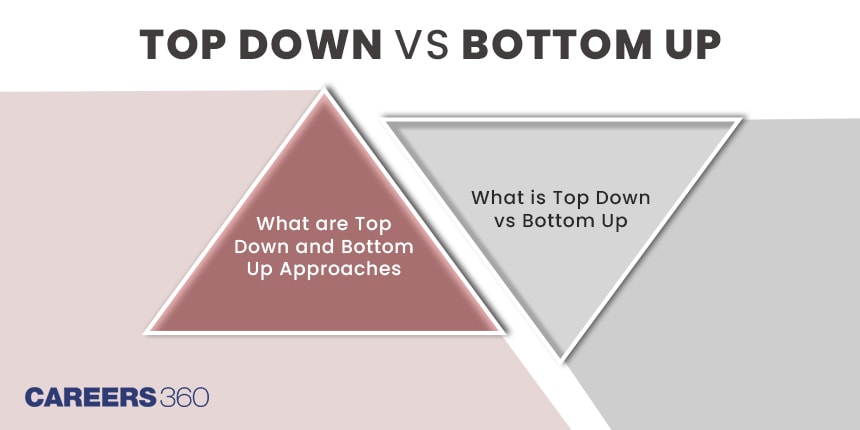JSS University Mysore 2025
NAAC A+ Accredited| Ranked #24 in University Category by NIRF | Applications open for multiple UG & PG Programs
In problem-solving and system development, two prominent strategies emerge: the top down approach and the bottom up approach. These methodologies offer distinct perspectives on how tasks are tackled, solutions are devised, and systems are built. The top down approach begins with a holistic view, systematically breaking down overarching objectives into manageable sub-tasks.

Conversely, the bottom up approach starts with specific elements, gradually building up to the overall system. In this article, we will explore the nuances, benefits, and considerations surrounding the difference between top down and bottom up approaches. If you are interested in gaining further knowledge in this field you can also have a look at IT And Systems Management Courses and Certifications listed on our website.
Also Read:
The top down approach, often termed the "big picture" method, initiates with an overarching view of the system. It begins with defining the broad objectives and systematically breaks them down into smaller, more manageable sub-tasks. This hierarchical decomposition continues until each sub-task is granular enough to be easily implemented. In essence, it starts from the conceptual and gradually delves into the specifics.
Also Read: Why IT Professionals Need to Upskill Themselves in Cloud Computing?
Conversely, the bottom up approach, as the name suggests, starts from the ground up. It begins with the development of individual components or modules, focusing on the nitty-gritty details. These smaller elements are gradually integrated to form more complex, higher-level structures. The process continues until the complete system is realised. In essence, it starts from the specifics and builds towards the larger structure.
Comparing top down vs bottom up approaches reveals that they are not mutually exclusive; rather, they can complement each other. Many projects use a combination, known as the hybrid approach, leveraging the strengths of both methodologies.
Top Down | Bottom Up |
Initially takes a holistic view, starting with the overall system design. | Initially focuses on the details, and then builds up to the overall system. |
Begins with a general concept, breaking it down into manageable tasks for implementation. | Starts with specific elements or modules, gradually combining them to achieve the final result. |
Generally suits well for large, complex systems, as it facilitates systematic decomposition. | Efficient for simpler systems or when building on existing components. |
Integration occurs towards the end of the process, once individual components are developed. | Ongoing integration happens as individual components are created, leading to a more iterative process. |
Allows for flexibility in adapting to changing requirements as the broader structure is not rigidly defined early on. | Can be more rigid initially, as it relies on predefined components. |
Often involves setting the overall strategies that guide the actions of the entire organisation. | As ideas from various levels are considered, this method often results in a more decentralised decision-making process. |
The decision between a bottom up vs top down approach often depends on the nature of the project, the level of detail required, and the project's overall objectives.
Strengths: Ideal for large projects, ensures a systematic approach, encourages a holistic view.
Considerations: May face challenges in detailed task planning initially.
Strengths: Effective for smaller projects, allows for detailed planning at the component level.
Considerations: Integration challenges may arise as components are combined.
In problem-solving and system development, understanding the difference between top down and bottom up approaches is pivotal. The choice between these methodologies depends on the project's scale, complexity, and the preferred level of detail at the initial stages.
While both approaches have their strengths and considerations, savvy project managers often find success in adopting a hybrid model that harnesses the advantages of both top down and bottom up approaches. As you understand system development, the knowledge of these approaches equips you to make informed decisions that align with your project's unique needs.
The top-down approach starts with a holistic view, breaking down overarching objectives into manageable sub-tasks, while the bottom-up approach begins with specific elements, gradually building up to the overall system.
The top-down approach is ideal for large projects, offering a systematic approach and encouraging a holistic view of the system.
In the bottom-up approach, ongoing integration occurs as individual components are created, leading to a more iterative process.
Yes, many projects use a hybrid approach, combining elements of both top-down and bottom-up methodologies to leverage their respective strengths.
Consider the project's scale, complexity, and the preferred level of detail at the initial stages. Savvy project managers often find success in adopting a hybrid model that harnesses the advantages of both approaches.
Ranked amongst top 3% universities globally (QS Rankings)
Ranked #1 Among all Private Indian Universities in QS Asia Rankings 2025 | Scholarships worth 210 CR
Ranked #46 amongst Universities in India by NIRF | 1900+ Students Placed | 94% Placement | 633+ Recruiters | Last Date to Apply: 28th April
#41 in NIRF | Highest Package 1.3 CR, Ranked #1 in Academic Reputation in India by QS World University Rankings | Last Date to Apply: 28th April
MSc Finance and MSc International Management Admissions 2025 Now Open | Ranked Among the Top 100 Universities in the World by QS World University Rankings 2025 | Last Date: 28th Apr'25
Ranked as India’s #1 Not for profit pvt. University by India Today